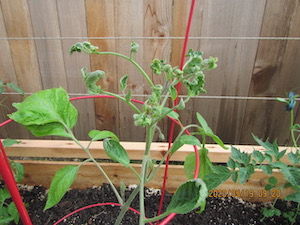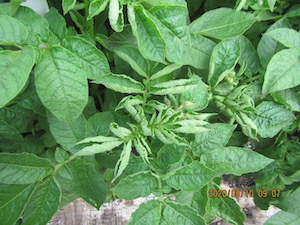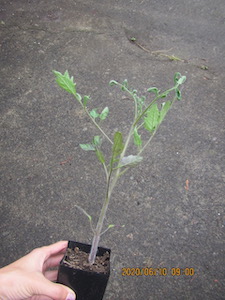Can I use compost contaminated with clopyralid or other herbicides?
1.800.858.7378npic@oregonstate.edu
We're open from 8:00AM to 12:00PM Pacific Time, Mon-Fri
A to Z


How can herbicides get into compost?
Herbicides used against broad-leaf weeds can sometimes end up in hay, manure, or grass clippings used for compost. Clopyralid is one of several herbicides that mimic auxins, or growth hormones, in plants. They can be used in pastures, where they kill weeds that may harm livestock.
The herbicide residues are not toxic to livestock, but can pass through their digestive tract unchanged. The residues then end up in the animals' urine and manure. If the manure or the hay from a treated pasture is taken away, the residues may go with it. This is called herbicide carryover.
How long does clopyralid last in soil?
Depending on soil conditions, clopyralid may last for months to years in soil. Soil microbes like bacteria and fungi help break down these herbicides. The healthier the soil, the faster the herbicide will break down.
How toxic is clopyralid?
Clopyralid is considered very low in toxicity if ingested or if it gets on the skin. When it was fed directly to pregnant rats, it was not found to cause birth defects. It did not affect the growth, survival, or reproduction of the rats born to those mothers. The EPA has concluded that clopyralid is not likely to cause cancer in humans based on several studies.1,2
Can I eat the food I've grown?
Pesticide residues in food are regulated by the EPA through the setting of tolerances, which are maximum residue limits. There are tolerances for clopyralid in meat and dairy products, grain crops, and some vegetables. There are no tolerances for clopyralid on most vegetables. This means that EPA has not done a risk assessment to set residue levels at which no health effects are expected. The risks are unknown.

What if I want to test for clopyralid?
Laboratory testing can be very expensive, and some plants are more sensitive than laboratory tests. They can be damaged by levels too low for lab tests to detect. You can perform your own bioassay instead. A bioassay is a test where you grow a few sensitive plants in soil to look for damage. The bioassay can take 3 to 4 weeks.
Lack of proper nutrients and other problems can look like herbicide damage. If you aren't sure what is affecting your plants, contact your local county extension office for help.
I used contaminated compost in the veggie garden. Now what?
There are a number of steps you may take. First, you may choose to plant your vegetables elsewhere until bioassays show no damage to test seedlings. This may take more than one growing season.
You may consider growing a cover crop of plants to dispose of later. Cover crops like sunflowers, peas, wheat, corn, or oats may or may not show damage, but they can help take up the residue. Remove the plants and their roots at the end of the growing season. You may consider sending them to a landfill or disposing of them in the normal trash. Do not compost or send them with yard debris where the cycle can start all over again.

Another option is to try speeding up the breakdown of the residues. Tilling the contaminated soil, watering it, and adding clean compost and soil can boost the soil microbes. Before you plant, you may choose to do a bioassay test to make sure residues are low enough not to cause damage.
Finally, you may choose to remove the contaminated soil. It can be spread on lawns or around woody and perennial ornamental plants. If you do this, grass clippings may be contaminated and should not be used for mulch or compost for the vegetable garden. Contaminated soil can also be taken to the landfill. This may be quite expensive.
How can I get rid of contaminated compost?
You can contact the company that sold the contaminated compost. They may not be required to remove it, but it could be part of a company’s customer service plan.
What can I do to avoid getting contaminated compost?
Before you purchase compost, ask the seller about the source. Ask what herbicides were used to grow the animals' feed or grass. Herbicides that can contaminate compost include clopyralid, aminopyralid, and picloram. Ask if the compost supplier does bioassays to test their product.
If you are getting grass clippings, ask if they came from a site that may have used these herbicides. If in doubt, do a bioassay or use the clippings around resistant ornamental plants.
Consider asking for a sample that you can bioassay yourself if the supplier does not perform a bioassay before selling the compost. Just be sure to sample the compost from the same load that you would buy.

This page should be used for informational purposes only. If you have questions, consider giving us a call at 800-858-7378 (8:00am - 12:00pm PST), or email us at npic@ace.orst.edu.
All images are courtesy of the Oregon Department of Agriculture, CC BY-NC-ND 4.0, creativecommons.org/licenses/by-nc-nd/4.0/legalcode
Additional Resources:
- Herbicide-Contaminated Compost and Soil Mix: What You Should Know — and What You Can Do About It - Oregon State University Extension
- Clopyralid Human Health and Ecological Risk Assessment - US Forest Service
- Herbicide carryover in hay, manure, compost and grass clippings - Oregon State University Extension
- Herbicide Contaminated Soil and Amendments - Montana State University Extension
- Clopyralid: Roadside vegetation management herbicide fact sheet - Washington Department of Transportation
- A Quick Test for Herbicide Carryover in Soil - University of Nebraska-Lincoln Extension Service
- Conducting a Bioassay for Herbicide Residues - North Carolina State University Extension
- EPA addresses ecological risks posed by four pyridines and pyrimidines herbicides - US Environmental Protection Agency
References:
- Chemicals Evaluated for Carcinogenic Potential; U.S. Environmental Protection Agency (EPA), Office of Pesticide Programs, U.S. Government Printing Office: Washington, DC, 2020.
- Clopyralid. Health Risk Assessment for New Uses on Apples, Teff, Brassica Leafy Greens, and Rapeseed; U.S. Environmental Protection Agency (EPA), Office of Pesticide Programs, U.S. Government Printing Office: Washington, DC, 2012.
